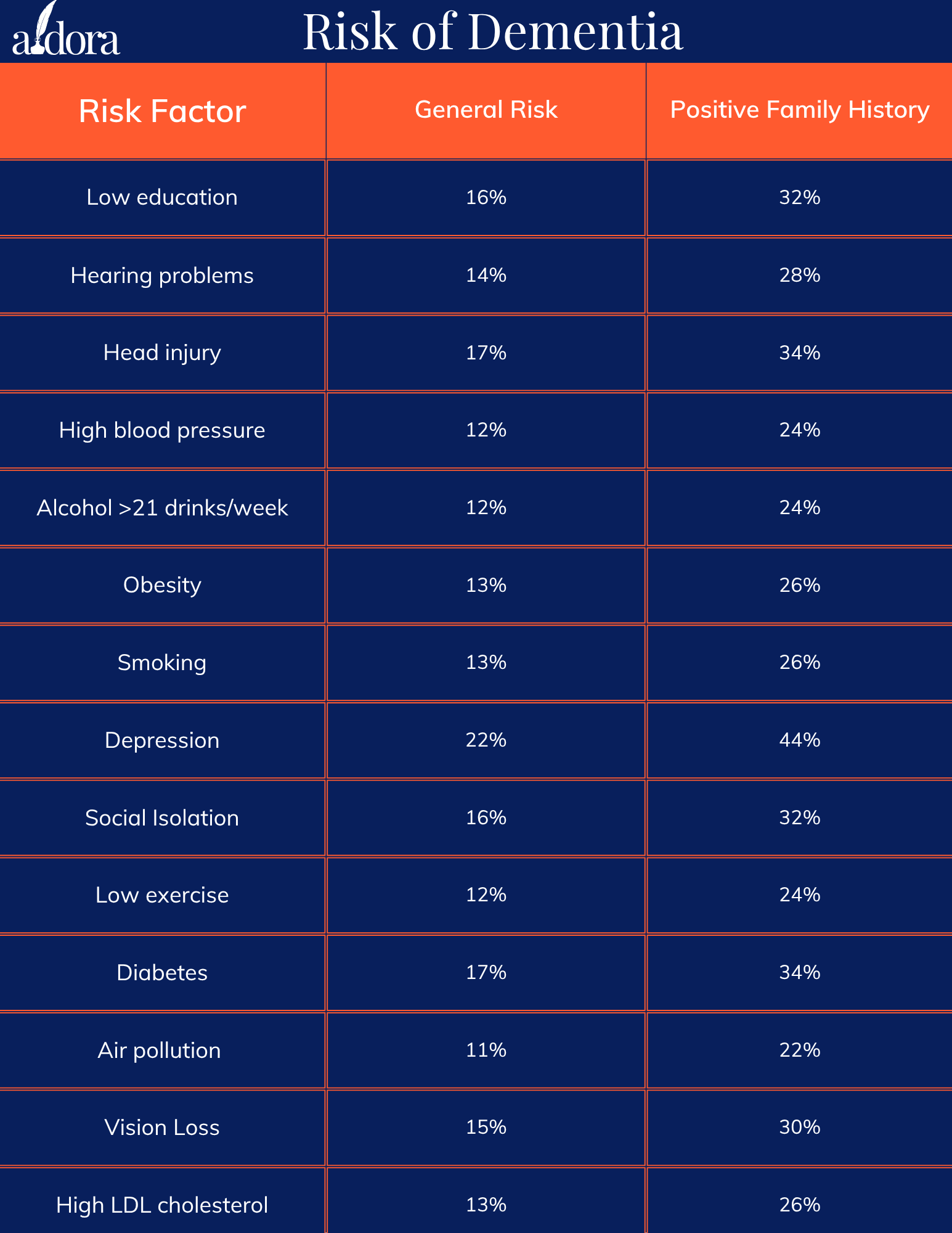Part 2: How much do different lifestyle factors increase my risk for dementia?
September 5 2024 | Last Updated: June 3 2025
Table of Contents
“Although behaviour change is difficult… individuals have a huge potential to reduce their dementia risk.”
In the second half of our two-part series on determining your risk of future dementia, we discuss the impact of lifestyle changes.
In 2024, a group of internationally renowned dementia experts found 14 modifiable risk factors for dementia that together account for at least 45% of dementia cases in the world.
In this article we discuss the impact of these lifestyle changes, reviewing the research and providing an estimate on the level of personal risk for each factor.
For help on figuring out your baseline risk, read Part 1.
What are the risk factors?
The 14 risk factors identified by the experts are shown below:
Based on Aldora’s clinical experience, we would also add the following as potential risk factors for dementia:
Poor sleep, including untreated sleep apnea
Certain medications with memory side effects
Anxiety / stress
Negative mindset
Unhealthy diet
We don’t have exact percentages of risk increase for these additional risk factors. However, in a recent Canadian study that included sleep as a risk factor, up to 68% of dementia cases were preventable. For the purposes of this article, we just focus on the risk factors in the diagram.
What is the risk?
To figure out how much a certain risk factor (like smoking or high blood pressure) increases your chances of getting dementia, we use something called “relative risk.”
You’ve probably seen this in health headlines — for example:
“Shingles vaccine lowers dementia risk by 20%”. That “20%” is the relative risk.
Why is this useful? It helps us take findings from big research studies and apply them to you personally — helping you understand what actions might make the biggest difference for your brain health.
The diagram below shows the relative risk for the 14 different risk factors in the previous diagram.
How do I read the chart? Just take the number after the decimal and add a 0. For example, a relative risk of 1.3 = 30% more risk. Likewise, a relative risk of 1.6 means a 60% increased risk. Easy.
Can relative risk be misleading? Yes. Relative risk tells you how much a factor changes your risk - not the final risk itself. That’s what we’ll show you how to do next.
What is my personal risk of dementia?
To figure out your personal risk of dementia, you need two numbers:
Your baseline risk (explained in Part 1)
The relative risk for any factor you have (outlined in red in the chart above)
For those who want to understand how the math works, keep reading. If you’d rather skip straight to the final estimate, scroll to the summary table below.
The math:
Step 1: What’s Your Baseline Risk?
Most people have a 10% lifetime risk of developing dementia.
If you have a genetic risk, like a family history or certain genes (e.g. APOE-e4), that number can be closer to 20%.
Step 2: Multiply by the Relative Risk
Use this simple formula: Baseline risk (as a decimal) × Relative risk = New personal risk
Example:
If you smoke, your relative risk is about 1.3.
If your baseline risk is 10% (or 0.1 in decimal form):
0.1 × 1.3 = 0.13
Which means your new lifetime risk becomes 13%.
The Summary:
The following table assumes a baseline lifetime risk of 10% for the general population, and 20% for people with a family history of dementia.
Based on research by Livingston et al, Lancet, 2024
Keep in Mind:
These numbers are estimates, not guarantees.
If you have more than one risk factor, the risks add up, but not in a simple way.
Some risk factors interact with each other. For example, hearing loss can lead to social isolation, which in turn may reduce hobbies and mood, all of which affect dementia risk.
So, while more risk factors mean a higher overall risk, the final number is not simply the sum of each percentage.
More personalized tools and risk calculators are currently in development.
Until then, this simple approach gives you a starting point to understand how your choices today may shape your brain health tomorrow.
Aldora’s guiding principles to dementia risk
Let’s put the math into practical action statements. Based on experience with thousands of real-life dementia cases, the following principles help to estimate your risk:
Focus on your personal risk factors with the greatest risk - and make sure those are well managed (find focus with the lifestyle quiz).
When you are a woman, it seems having 5-6 risk factors makes having dementia in your 80’s very likely.
When you are a man we tend to see that hearing, alcohol, depression, and head injuries are common causes that trigger dementia in your 70’s-80’s.
The severity of the risk factor matters - drinking 50 beers a week is worse than drinking 16.
True longevity means protecting your whole body, including your brain. Modern medicine can help you live longer, but without active dementia prevention many people live longer with memory loss.
The goal: aim to have no more than 2-3 out of Aldora’s 18 risk factors
Remember: you can remove the risk if you do something about it. Using hearing aids, taking medications for high blood pressure, going for a walk, cutting down on alcohol… all of these things can remove the risk of dementia to yourself.
So - let’s start doing something about lowering your risk, starting today.
More like this
Disclaimer: The content on Aldora Health is for educational and informational purposes only and is not intended to substitute for professional medical advice, diagnosis, or treatment. Always seek the advice of your physician or other qualified health provider with any questions you may have regarding a medical condition. For more read our Terms of Use.









